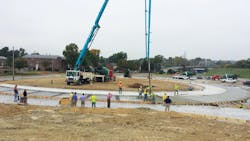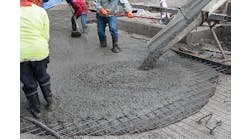Newport on the Levee is a retail area in northern Kentucky in need of a connector.
Claire’s, Barnes & Noble and unique local businesses such as Kelly’s Kloset can all be found there. You can even see hand-crafted concrete, which is on display and will serve as a traffic management solution while also driving the economy to the Levee.
There has never been an easy way to get to the shopping district. Those travelling on I-275 and S.R. 9 rely on arterial roads to get by, but soon there will be an easier way to get around thanks to the $8.7 million Kentucky 9 Connector, which is scheduled to be complete in December 2017. In late December 2016, prime contractor Prus Construction was busy working on the largest of two roundabouts on the project and the road in between. All the work is being done by hand.
The job was broken up into three phases. Phase 1 involved the continuation of
S.R. 9—a four-lane highway with a grass-center median. Phase 3 contains the two roundabouts and Phase 2 is currently in limbo due to a sudden shift in state funding.
“We are all lobbying the new governor,” Greg Smith, director of paving for the Kentucky Concrete Paving Association, told Roads & Bridges. “He got into office and re-did all of the funding and claimed the old governor left the coffers empty, so [Phase 2] got dropped away a bit. I think it is getting back on track.”
Kentucky has been high on roundabouts for the last few years, and contractors submitting bids for the Kentucky 9 Connector were allowed to submit an asphalt alternate design. However, concrete was the material of choice. Some have even claimed the major roundabout in the Connector job to be the largest in Kentucky. It certainly will be the king of the northern region.
“Right now there are over 9,000 cars a day using the surface streets, so the idea is getting the people out of the neighborhoods and taking them through quicker,” Tim Knapke, project manager for Prus Construction, told Roads & Bridges.
Circling it
When complete, the main roundabout of the Kentucky 9 Connector will have a 125-ft radius and feature a 40-ft-wide roadway that will carry three lanes of traffic. According to Knapke, the circle was 40% complete in early December. Prus Construction is using prefabricated load transfer devices 11⁄4 in. in diam. by 18 in. long that are 12 in. on center that run horizontally. The dowel bar basket (No. 5 rebar) assembly runs longitudinally to form a standard grid. The basket assembly running the line of the curb helps keep the different lanes from settling next to one another.
The state of Kentucky typically allows a maximum of 15 ft between joints, but on this job joints are at 23 ft due to the different stresses and forces from the expected traffic. Prus Construction also is used to working with metal forms, but timber is being used on the Kentucky 9 Connector. The use of lumber forced the contractor to use a lighter screed and prevented the wide and long pours it was accustomed to executing. At the beginning—with a 39-m concrete pump located in the center of the roundabout—crews were pouring at 28-30 ft wide with a crown and 2% slope in each direction. In early December they were pouring 14-18 ft wide in one constant slope. Prus Construction used a Kentucky Class P mix design that consisted of 35% gravel and 38% stone and a water/cement ratio of 0.49. A mid-range plasticizer and an accelerator also were used. The plasticizer is allowing crews to increase the slump of the concrete and work with the mix a little longer, which is vital in a job where concrete is being placed by hand. A vibratory screed also is being used. The pavement is 10 in. thick and is reaching a 3,500 psi in seven days with the help of a curing compound that is sprayed on the mat. Tining (1⁄8 in. depth) also is being done by hand with a broom. All saw cutting is being done at night.
“[The pours] have been a little slow, a little chopped up,” said Knapke. “We have all of these different approaches coming into the roundabout so there are different stresses and different joints. Some are reinforced, some are not. Some have expansion papers in them to help the concrete expand and contract.”
The second roundabout, which will have a 105-ft radius but also carry a 40-ft-wide roadway, is stuck in the currently unfunded Phase 2 portion of the project. However, Prus Construction is working on the road that will connect the two. At press time it was about 70% complete. The 1,000-ft connector will consist of four lanes—a 13-ft-wide travel lane and a 10-ft-wide parking lane in each direction—and will have island medians when complete, and paving is being done all by hand in 300-ft sections.
Water separation
Perhaps the most difficult part of the project does not actually involve paving at all. Prus Construction has to do a sewer separation and will install a 14-ft by 14-ft by 27-ft-deep concrete structure that will feature 66-in.-diam. pipes and will connect to a pumping station, all in an effort to separate sanitary water from the storm sewer lines. The placement will take place near the Fourth Street Bridge which crosses the Licking River.
“We built the structure in Phase Three but in Phase Two, which connects the two pieces, they ultimately have to tunnel under the flood wall to outlet this structure and pipe.”



